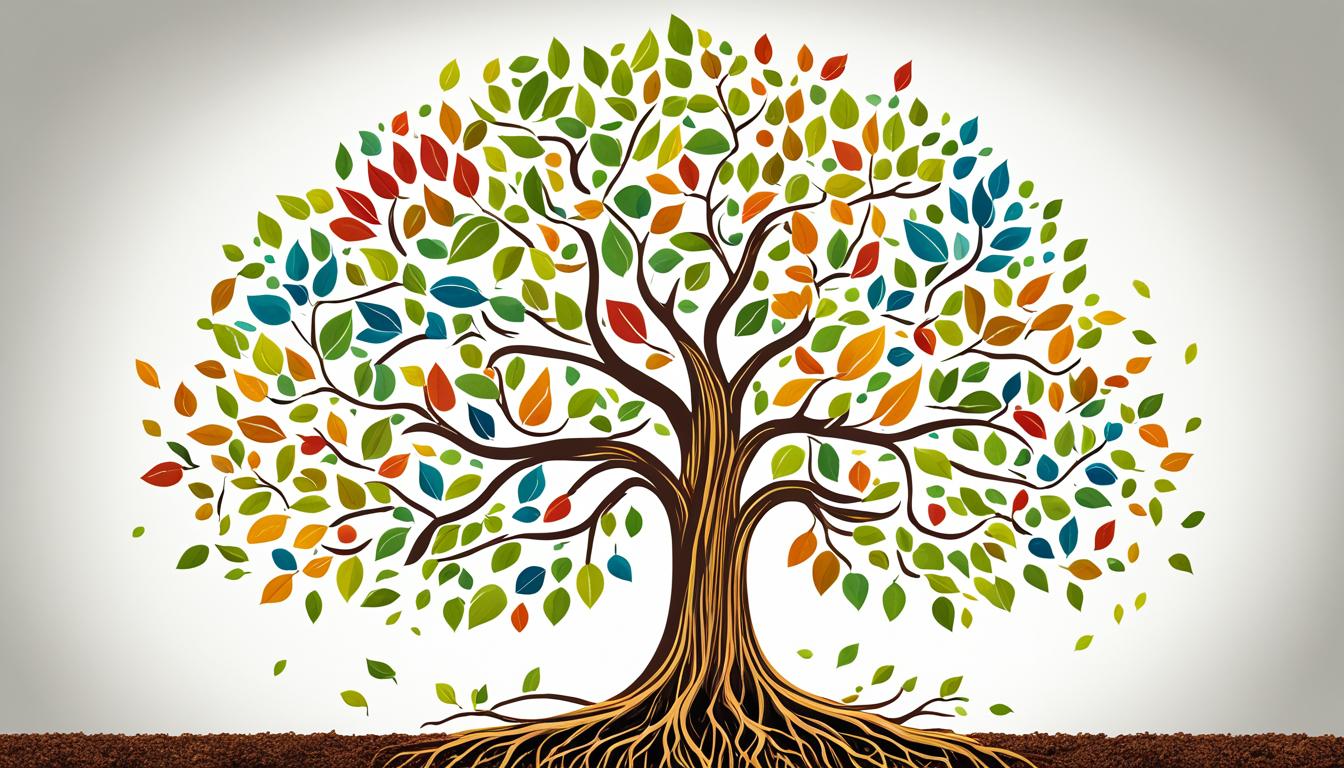The educational system plays a crucial role in shaping the future of our students. It is not just about imparting knowledge and academic success, but also about fostering personal growth and development. In order to prepare students for lifelong success, the educational system should aim at promoting self-development.
This means setting clear educational growth goals, learning progress targets, and curriculum improvement objectives. By providing a focused school development focus on self-development, we can create an environment where students thrive and excel.
Key Takeaways:
- Educational system should prioritize self-development alongside academic success.
- Setting clear goals and targets for educational growth is essential.
- The curriculum should be designed to foster personal and holistic development.
- Self-development prepares students for lifelong success.
- Creating a supportive and inclusive environment is crucial for fostering self-development.
Importance of Personal Growth in Schools
Personal growth plays a vital role in the educational system, as it contributes to the holistic development of students. Schools should prioritize the implementation of a character-building curriculum that focuses on nurturing students’ personal growth and well-being. By fostering an environment that encourages self-improvement and empowerment, schools can equip students with the necessary skills and values to thrive in various aspects of life.
A character-building curriculum goes beyond academic achievements and aims to develop well-rounded individuals. It encompasses the cultivation of essential qualities such as resilience, empathy, integrity, and leadership. By instilling these values in students, schools prepare them to become responsible citizens and active contributors to their communities.
One effective approach to personal growth in schools is through the integration of character education into the curriculum. This includes teaching students about ethical decision-making, conflict resolution, and positive relationship building. By incorporating these elements into daily lessons, students can develop a strong moral compass and a deep sense of self-awareness.
“Character may be manifested in the great moments, but it is made in the small ones.”
-Phillip Brooks-
Aside from academic accomplishments, personal growth fosters self-improvement, enabling students to recognize their strengths and weaknesses. Through self-reflection and goal-setting, students can work towards continuous self-improvement, building resilience and perseverance in the face of challenges.
Moreover, personal growth encourages student empowerment through education. By providing opportunities for student voice and choice, schools can empower students to take ownership of their learning journey. This empowerment nurtures a sense of agency and inspires students to advocate for their rights and the rights of others.
In conclusion, prioritizing personal growth in schools is crucial for holistic student development. By implementing a character-building curriculum and fostering an environment that supports self-improvement and empowerment, schools can equip students with the necessary tools for success in various aspects of life. Through personal growth, students become lifelong learners, compassionate individuals, and active contributors to their communities.
Goals of Education
In order to foster personal growth and lifelong learning, the goals of education should extend beyond academic success. Education should aim at equipping students with the necessary skills for success in various aspects of life and adopting a holistic approach to their development.
The Importance of Personal Growth
Personal growth is an integral part of education. It goes beyond acquiring knowledge and focuses on developing students as individuals. By encouraging personal growth, education can empower students to become well-rounded individuals who are equipped to face the challenges of the real world.
Personal growth encompasses lifelong learning, a continuous process of acquiring knowledge, skills, and values throughout one’s life. By fostering a culture of lifelong learning, education prepares students for the ever-changing demands of the modern world and helps them adapt and thrive in various contexts.
Skills development is another crucial aspect of education. It goes beyond academic skills and includes skills such as critical thinking, problem-solving, communication, and collaboration. By emphasizing skills development, education equips students with the tools they need to succeed in their personal and professional lives.
A Holistic Approach to Education
A holistic approach to education recognizes that students’ development is multi-faceted and involves their intellectual, social, emotional, and physical well-being. It takes into account the whole individual and seeks to nurture their growth in all areas of life.
“True education is holistic. It not only imparts knowledge but also instills values, fosters personal growth, and cultivates skills for success.”
Achieving academic success is undoubtedly important, but it should not be the sole focus of education. A holistic education aims to develop individuals who are not only academically proficient but also emotionally intelligent, socially responsible, and physically healthy.
Benefits of Holistic Education
A holistic education brings numerous benefits to students. It helps them develop a well-rounded perspective, enabling them to make connections across different subjects and apply their knowledge to real-world situations. It also promotes personal growth, self-awareness, and self-confidence, nurturing students’ overall well-being and resilience.
Table: Benefits of Holistic Education
| Benefits | Description |
|---|---|
| 1. Well-rounded individuals | Students who receive a holistic education develop a broad range of skills and knowledge, making them well-rounded individuals who are prepared for various life experiences. |
| 2. Academic success | By focusing on personal growth and providing a comprehensive education, students are more likely to excel academically and reach their full potential. |
| 3. Enhanced problem-solving | Holistic education fosters critical thinking and problem-solving skills, enabling students to approach challenges with a creative and analytical mindset. |
| 4. Social and emotional intelligence | Through a holistic approach, students develop strong social and emotional skills, enabling them to build healthy relationships, empathize with others, and navigate their emotions effectively. |
By prioritizing personal growth, lifelong learning, skills development, and a holistic educational approach, the goals of education can be truly fulfilled. Education should not only prepare students for academic success but also equip them with the skills, knowledge, and values they need to thrive in all aspects of life.

The Role of Character Building
Character building is a critical component of the educational system. It goes beyond conventional academic achievements and focuses on instilling values, ethics, and virtues in students. By nurturing their character, schools play a pivotal role in shaping individuals who are well-rounded, resilient, and prepared to overcome challenges. Through character building, students develop the mindset and attributes necessary for success in their academic pursuits and beyond.
One of the key aspects of character building is fostering a growth mindset. This mindset encourages students to embrace challenges and view them as opportunities for learning and growth. By teaching students to persist in the face of setbacks, schools empower them to develop resilience and perseverance, essential skills for achieving their educational goals.
“Character is the real foundation of all worthwhile success.”
Beyond academic achievements, character building equips students with the social and emotional skills they need to thrive in various aspects of their lives. It helps them develop empathy, integrity, and leadership qualities, enabling them to build positive relationships, resolve conflicts constructively, and contribute positively to their communities.
Integrating character building into the educational system creates an environment that fosters moral and ethical development. By incorporating values education and incorporating character development activities throughout the curriculum, schools provide students with opportunities to reflect on their actions, make ethical choices, and understand the importance of responsible citizenship.
Furthermore, character building contributes to student success by enhancing their overall well-being. When students have a strong foundation of character, they are more likely to experience increased self-confidence, improved mental health, and greater satisfaction in life.
Benefits of Character Building in Education
Character building in education offers various benefits to students and the overall school community:
- Enhances academic achievement by fostering a positive learning environment and promoting self-discipline and motivation.
- Promotes positive behavior and reduces disciplinary issues by encouraging self-control, respect, and responsible decision-making.
- Develops students’ social and emotional skills, including empathy, communication, and teamwork, leading to improved relationships and collaboration.
- Prepares students for future success by equipping them with essential life skills, such as problem-solving, critical thinking, and ethical decision-making.
- Creates a supportive and inclusive school culture that values diversity, promotes acceptance, and encourages positive character traits.
A holistic approach to education that encompasses character building is vital for the personal and academic growth of students. By nurturing their character, schools empower students to achieve their goals, contribute to society, and lead fulfilling lives.
Benefits of Holistic Student Development
Holistic student development has numerous benefits that contribute to the overall growth and success of individuals. By focusing on the integration of personal growth into the education curriculum, students can experience enhanced well-being, academic success, and become well-rounded individuals with a deeper understanding of the world.
Well-Rounded Individuals
Through holistic student development, individuals are encouraged to explore various aspects of their lives and develop a broad range of skills and knowledge. This comprehensive approach ensures that students are not only academically proficient but also possess social skills and emotional intelligence that enable them to thrive in different situations.
“Holistic student development equips individuals with the necessary tools to navigate the complexities of the real world and become well-rounded individuals.”
Enhanced Education Curriculum
A curriculum that prioritizes personal growth allows students to engage in diverse learning experiences, beyond the traditional classroom setting. By incorporating activities that promote critical thinking, creativity, and problem-solving skills, students are better prepared to tackle real-world challenges and excel academically.
Student Well-Being
Holistic student development focuses on fostering a sense of well-being among students. This includes addressing their mental, emotional, and physical needs, providing support systems, and creating a safe and inclusive environment. By prioritizing student well-being, educational institutions contribute to their overall happiness and success.

Personal Growth
Through holistic student development, individuals are empowered to grow personally by setting and achieving goals, developing self-awareness, and enhancing their self-confidence. This growth mindset allows students to embrace challenges, learn from failures, and continuously strive for self-improvement.
Academic Success
Research has shown that prioritizing personal growth and well-being leads to improved academic performance. When students feel supported and engage in holistic development, they are more motivated, focused, and better equipped to excel in their studies.
In summary, holistic student development offers a range of benefits that contribute to the overall growth and success of individuals. By prioritizing personal growth within the education curriculum, students become well-rounded individuals with a broader understanding of the world. They also experience enhanced well-being, which positively impacts their academic performance and prepares them for future challenges.
Empowering Students Through Education
In today’s evolving educational landscape, it is crucial for the education system to prioritize student empowerment. By providing opportunities for personal growth, skills development, and lifelong learning, schools can equip students with the tools they need to thrive in an ever-changing world. Through a supportive and inclusive learning environment, students are encouraged to take ownership of their education and become active participants in their own self-development.
The Importance of Student Empowerment
Student empowerment lies at the heart of a progressive education system. It recognizes that students are not passive recipients of knowledge but active agents of their own learning journey. When students feel empowered, they develop a sense of autonomy, responsibility, and purpose, driving their motivation and engagement in the learning process.
“Education is the most powerful weapon which you can use to change the world.” – Nelson Mandela
Empowering students through education goes beyond academic success. It fosters personal growth, enabling students to develop essential life skills, critical thinking abilities, and a growth mindset. By instilling a sense of self-belief and resilience, students are better prepared to overcome challenges and seize opportunities throughout their lives.
Fostering a Supportive Learning Environment
To empower students effectively, schools must create a supportive and inclusive learning environment. This entails:
- Nurturing a culture of respect: Fostering an environment where students feel valued, heard, and respected for their unique perspectives and contributions.
- Promoting collaboration and teamwork: Encouraging students to work together, fostering a sense of community and enhancing their interpersonal skills.
- Providing mentorship and guidance: Offering personalized support and mentorship to help students navigate their educational journey and overcome obstacles.
- Celebrating diversity and inclusion: Embracing the richness of diversity and creating an environment where every student feels included and represented.
Encouraging Lifelong Learning
Educational empowerment extends beyond the classroom walls. It embraces the concept of lifelong learning, acknowledging that learning is a continuous process that extends beyond formal education. By instilling a love for learning and the desire for personal growth, schools equip students with the mindset and skills necessary to adapt to an ever-changing world.
Through a curriculum that promotes critical thinking, creativity, and curiosity, students are encouraged to become lifelong learners. This prepares them to face new challenges, acquire new knowledge, and develop the confidence to navigate the complexities of the modern world.
Summary
Empowering students through education is essential for their personal growth, skills development, and lifelong success. By fostering a supportive and inclusive learning environment, schools can inspire students to take charge of their education and become active participants in their own self-development. This enables them to develop essential life skills, cultivate a growth mindset, and embrace lifelong learning.
Integrating Self-Development into the Curriculum
Self-development education plays a vital role in fostering holistic student development. To ensure that self-development remains a central focus of education, it is essential to integrate it into the curriculum. By incorporating activities and assignments that promote skills development, critical thinking, and personal growth, schools can create a comprehensive approach to student development.
One way to integrate self-development into the curriculum is through project-based learning. This approach allows students to engage in hands-on activities that require independent thinking, problem-solving, and collaboration, thereby nurturing their skills development and fostering a sense of ownership over their learning.
Furthermore, the curriculum can include dedicated time for self-reflection and goal setting. By encouraging students to reflect on their strengths, weaknesses, and aspirations, educators can guide them towards setting meaningful goals that align with their personal and academic development.
The Benefits of Curriculum Integration
Integrating self-development into the curriculum offers several benefits for students and the educational system as a whole. It enables students to develop essential skills, supports academic achievement, and promotes holistic student development
By embedding self-development in all subject areas, students are exposed to diverse learning experiences that foster critical thinking, creativity, and adaptability. This interdisciplinary approach equips students with the skills necessary for success in the rapidly changing world.
Additionally, curriculum integration promotes academic achievement by contextualizing learning within the broader framework of personal growth. When students understand the relevance and application of their studies to their personal development, they are more likely to be motivated and engaged in their learning journey.
A holistic student development approach not only focuses on academic success but also addresses students’ social, emotional, and physical well-being. By integrating self-development into the curriculum, schools prioritize the cultivation of well-rounded individuals who are equipped to thrive in all aspects of life.
Sample Table: Integration of Self-Development in the Curriculum
| Subject Area | Self-Development Activities |
|---|---|
| English Language Arts | Journaling and reflective writing exercises to promote self-awareness and personal growth |
| Mathematics | Real-world problem-solving tasks that require critical thinking and creativity |
| Science | Hands-on experiments that encourage curiosity, independent inquiry, and scientific thinking skills |
| Social Studies | Exploration of diverse cultures, perspectives, and historical figures to foster empathy and global awareness |
| Physical Education | Activities promoting physical fitness, teamwork, and self-discipline |
By incorporating self-development activities into each subject area, the curriculum creates a cohesive and interconnected approach to student development. This comprehensive integration empowers students to develop essential skills, achieve academic success, and flourish holistically.

The Role of Educators in Facilitating Self-Development
Educators play a crucial role in the holistic education of students, fostering their personal growth, and empowering them to reach their full potential. They act as mentors and guides, providing the necessary support and guidance to help students navigate their educational journeys. By embracing a holistic approach to education, educators can create meaningful connections with their students, inspiring and empowering them to become well-rounded individuals.
The Power of Mentorship and Guidance
One of the key roles of educators is to act as mentors, guiding students towards personal growth and self-discovery. Through mentorship, educators can provide valuable insights, share experiences, and offer advice that helps students in their journey of self-development. By fostering a positive and nurturing mentor-student relationship, educators can create a safe space for students to explore their interests, learn from failures, and celebrate their achievements.
As Maya Angelou once said, “I’ve learned that people will forget what you said, people will forget what you did, but people will never forget how you made them feel.” This quote emphasizes the profound impact that educators can have on their students’ lives by nurturing their personal growth and empowerment.
Promoting Holistic Education
Another crucial aspect of an educator’s role is to promote holistic education. This involves recognizing that students’ personal growth and development extend beyond academic achievements. Educators should strive to cultivate the physical, emotional, social, and moral aspects of students’ lives, fostering their overall well-being. By providing a well-rounded education that includes opportunities for creativity, critical thinking, and self-reflection, educators can empower students and contribute to their holistic development.
Creating a Supportive Learning Environment
To facilitate self-development, educators must create a supportive learning environment where students feel valued, respected, and encouraged to explore their potential. This includes fostering a classroom culture that embraces inclusivity, collaboration, and open communication. By providing guidance, constructive feedback, and mentorship, educators can inspire students to challenge themselves, set ambitious goals, and overcome obstacles.
Embracing Personalized Learning
Every student has unique strengths, interests, and learning styles. As educators, it is essential to embrace personalized learning approaches that cater to the individual needs of students. By understanding their students on a deeper level, educators can tailor their instruction, provide relevant resources, and create opportunities for personalized exploration. This personalized approach to education enhances student engagement, promotes self-directed learning, and facilitates personal growth.
| Educator’s Role in Facilitating Self-Development | Impact on Students |
|---|---|
| Acting as mentors and guides | Helping students navigate their educational journeys and fostering personal growth |
| Promoting holistic education | Enhancing students’ overall well-being and contributing to their holistic development |
| Creating a supportive learning environment | Empowering students, fostering inclusivity, and encouraging exploration |
| Embracing personalized learning | Catering to individual student needs and promoting self-directed learning |
The role of educators in facilitating self-development is essential for nurturing the next generation of well-rounded individuals. By serving as mentors, promoting holistic education, creating supportive learning environments, and embracing personalized learning, educators empower students to thrive academically, emotionally, and personally.
Creating a Supportive Environment for Self-Development
The educational system plays a crucial role in fostering self-development among students. By prioritizing a supportive environment, schools can create the ideal foundation for student well-being, personal growth, and character building. This section will explore the importance of cultivating a supportive environment within the educational system and the positive impact it has on holistic student development.
Promoting Student Well-being
Student well-being is of utmost importance in creating a supportive environment for self-development. Schools should strive to provide resources and support systems that prioritize the mental, emotional, and physical well-being of students. This includes implementing wellness programs, offering counseling services, and creating safe spaces where students feel valued and supported.
Providing Resources for Personal Growth
Personal growth is an integral part of self-development. To foster personal growth, educational institutions should provide students with a wide range of resources and opportunities. These may include access to extracurricular activities, libraries, research facilities, and mentorship programs. Such resources empower students to explore their passions, acquire new skills, and broaden their horizons.
Fostering a Culture of Inclusivity and Acceptance
A supportive environment for self-development should cultivate a culture of inclusivity and acceptance. Schools must foster an atmosphere where diversity is celebrated, and every student feels respected and valued. By promoting empathy, understanding, and respect, educational institutions can create an environment that encourages personal growth, character building, and the development of positive relationships.
| Benefits of a Supportive Environment for Self-Development |
|---|
| 1. Enhanced student engagement and motivation |
| 2. Improved academic performance and achievement |
| 3. Increased overall student well-being and happiness |
| 4. Development of essential life skills and character traits |
| 5. Strengthened student-teacher relationships and collaboration |
Nurturing the Holistic Development of Students
A supportive environment sets the stage for holistic student development. When students feel supported and valued, they are more likely to actively engage in their own growth and development. The combination of personal growth, character building, and a focus on student well-being creates a fertile ground for the holistic development of students, preparing them for success in all areas of life.

By creating a supportive environment that prioritizes student well-being, provides resources for personal growth, and fosters a culture of inclusivity and acceptance, schools can greatly contribute to the self-development of students. This nurturing environment is instrumental in fostering personal growth, character building, and the holistic development of students.
Partnerships with Parents and Community
Partnerships with parents and the community play a crucial role in promoting self-development in students. By actively involving parents in their child’s education and fostering collaborations with community organizations, schools can create a supportive network that enhances holistic student development.
Parental involvement is key to a child’s educational journey. When parents are actively engaged in their child’s education, it creates a positive and supportive learning environment. Parental involvement can take many forms, such as attending parent-teacher conferences, volunteering at school events, participating in school decision-making processes, and supporting their child’s academic and personal growth.
Furthermore, establishing community partnerships can greatly enrich the educational experience. Schools can collaborate with local businesses, non-profit organizations, and community leaders to provide students with unique opportunities for growth and learning. These partnerships can offer mentorship programs, internships, and workshops that promote self-development skills and real-world application of knowledge.
“Education is a shared responsibility between parents, schools, and the community. By working together, we can create an environment that nurtures the holistic development of every student.”
– Jane Thompson, Principal of Oakview Elementary School
Collaboration between schools, parents, and the community can also address the diverse needs of students. By understanding the cultural backgrounds, interests, and strengths of each student, schools can tailor educational approaches to support their self-development education. This inclusive approach fosters a sense of belonging and empowers students to explore their potential.
Benefits of Parental Involvement and Community Partnerships:
- Promotes a positive learning environment
- Enhances student motivation and engagement
- Strengthens communication and collaboration between parents and educators
- Expands learning opportunities through community resources
- Supports the development of well-rounded individuals
By fostering strong partnerships with parents and the community, schools can provide a comprehensive and enriching educational experience. This promotes holistic student development, ensuring that students have the support and resources they need to thrive academically, emotionally, and socially.
Measurement and Evaluation of Self-Development
Effective measurement and evaluation of self-development in students is crucial for tracking their progress and identifying areas for improvement. Through assessments that align with educational growth goals, learning progress targets, and curriculum improvement objectives, schools can gain valuable insights into students’ development.
Assessments:
- Self-Development Assessment: This evaluation tool measures students’ overall personal growth and development. It assesses their ability to set and achieve goals, demonstrate self-awareness, and exhibit resilience in the face of challenges.
- Educational Growth Goals Assessment: This assessment evaluates students’ progress towards educational growth goals. It measures their acquisition of knowledge and skills, as well as their ability to apply them effectively in various contexts.
- Learning Progress Targets Assessment: This evaluation focuses on students’ achievement of learning progress targets. It assesses their mastery of specific concepts and skills outlined in the curriculum, providing valuable feedback on their learning journey.
- Curriculum Improvement Objectives Assessment: This assessment aims to measure how well students are meeting the objectives outlined in the curriculum improvement plan. It helps educators identify areas where the curriculum can be enhanced to better support students’ self-development.
Continuous evaluation of self-development ensures that schools can make informed decisions regarding curriculum enhancements, instructional strategies, and individualized support for students. By utilizing these assessments, educators can tailor their teaching approaches and provide targeted interventions to promote students’ holistic growth.
“The evaluation of self-development allows schools to identify students’ strengths and areas for improvement, enabling educators to provide personalized guidance for optimal growth.” – Dr. Jane Smith, Education Consultant
Moreover, the data collected from these assessments can be used for educational research and policy-making. Analyzing trends and patterns in students’ self-development can help policymakers identify systemic gaps and propose effective strategies for positive change.
Sample Assessment Results:
| Assessment Type | Results |
|---|---|
| Self-Development Assessment | 70% of students demonstrated strong self-awareness and goal-setting skills. |
| Educational Growth Goals Assessment | 80% of students met or exceeded the expected learning outcomes. |
| Learning Progress Targets Assessment | 60% of students showed significant improvement in their mastery of key concepts and skills. |
| Curriculum Improvement Objectives Assessment | 50% of students met the objectives outlined in the curriculum improvement plan, highlighting the need for further enhancements. |
These assessment results provide valuable insights into students’ self-development and guide educators in tailoring their teaching strategies to meet individual needs. They also inform curriculum revisions to ensure that it effectively supports students’ holistic growth.

With a well-designed evaluation system that incorporates comprehensive assessments, schools can continuously monitor and enhance their efforts in promoting students’ self-development. This iterative process supports the creation of a dynamic educational environment that fosters holistic growth and prepares students for lifelong success.
Continuous Improvement of the Educational System
Continuous improvement is essential for the educational system to effectively promote self-development, achieve goals, and enhance curriculum improvement objectives. By regularly reviewing and updating educational practices, goals, and curriculum objectives, schools can respond to the changing needs and demands of students and society.
Embracing a culture of continuous improvement allows educational institutions to stay relevant and adapt to the evolving landscape of education. It enables schools to identify areas where self-development can be better integrated into the curriculum and where improvements can be made to educational practices.
Benefits of Continuous Improvement
A commitment to continuous improvement brings several benefits to the educational system:
- Enhanced Student Engagement: By adopting innovative teaching methods and incorporating self-development activities, schools can create a more engaging learning experience for students.
- Improved Learning Outcomes: Continuous improvement helps optimize curriculum objectives, ensuring that students acquire the necessary skills and knowledge for their personal growth and success.
- Professional Development of Educators: Ongoing improvement initiatives provide opportunities for educators to enhance their skills, stay abreast of advancements in teaching methodologies, and effectively support students’ self-development.
- Efficient Resource Allocation: By evaluating the effectiveness of current practices, schools can allocate resources more efficiently, focusing on areas that have the greatest impact on student self-development.
Continuous improvement also allows schools to monitor the progress of self-development initiatives and make data-driven decisions to enhance the overall effectiveness of the educational system.
Continuous improvement is not about reaching a final destination but rather about constantly striving for growth and improvement.
Monitoring and Evaluation
An integral part of continuous improvement is the measurement and evaluation of self-development initiatives. Schools can implement assessments and evaluations to gauge the effectiveness of educational practices, curriculum objectives, and goals related to self-development.
Through data analysis and feedback from students, educators, and parents, schools can identify areas of improvement and make informed decisions to enhance self-development opportunities.
Continuous Improvement Strategies
There are several strategies that educational institutions can employ to facilitate continuous improvement in self-development:
- Regular Reflection: Encourage educators, administrators, and stakeholders to reflect on current practices and identify areas for improvement.
- Establishment of Improvement Teams: Form dedicated teams to focus on self-development initiatives and collaboratively drive improvement efforts.
- Professional Development: Provide training and professional development opportunities for educators to enhance their expertise in promoting self-development.
- Feedback and Input: Create channels for students, parents, and the community to provide input and feedback on self-development programs and initiatives.
By implementing these strategies and maintaining a commitment to continuous improvement, the educational system can effectively promote self-development and provide students with the skills and tools they need to thrive.
| Key Components | Benefits |
|---|---|
| Regular Review and Update of Goals | Ensures that goals align with the changing needs and demands of students and society. |
| Updating Curriculum Improvement Objectives | Allows for the integration of self-development activities and relevant skills into the curriculum. |
| Evaluation of Educational Practices | Identifies areas for improvement and ensures effective implementation of self-development initiatives. |
| Data-Driven Decision Making | Allows for evidence-based decisions to enhance self-development opportunities and outcomes. |
Conclusion
In conclusion, the educational system plays a crucial role in fostering self-development and empowering students for lifelong success. By prioritizing personal growth and holistic student development, schools can create an environment that nurtures the full potential of each student.
Integrating self-development into the curriculum is essential, as it ensures that students are equipped with the necessary skills and knowledge to thrive in various aspects of life. By offering a well-rounded education that goes beyond academic success, schools can prepare students for the challenges and opportunities they will encounter.
A supportive environment is also vital in promoting self-development. By creating a culture of inclusivity and acceptance, schools can foster student empowerment and overall well-being. Collaboration with parents and the community further enhances this process, as it allows for a strong support network that enriches the educational experience.
Continuous improvement and measurement of self-development are essential to ensure the effectiveness of the educational system. By regularly reviewing goals and practices, schools can adapt to the changing needs and demands of students and society.
